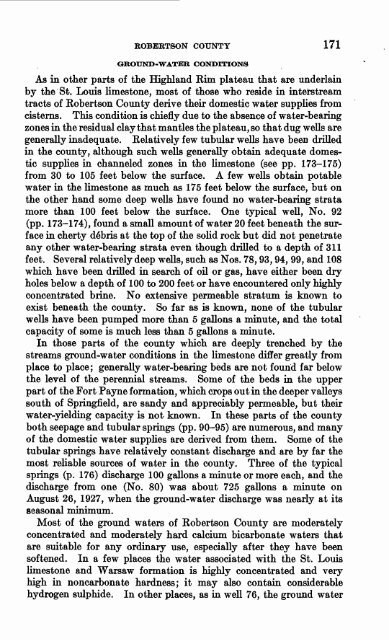GROUND WATER IN NORTH-CENTRAL TENNESSEE
GROUND WATER IN NORTH-CENTRAL TENNESSEE
GROUND WATER IN NORTH-CENTRAL TENNESSEE
You also want an ePaper? Increase the reach of your titles
YUMPU automatically turns print PDFs into web optimized ePapers that Google loves.
EOBEETSON COUNTY 171<br />
<strong>GROUND</strong>-<strong>WATER</strong> CONDITIONS<br />
As in other parts of the Highland Rim plateau that are underlain<br />
by the St. Louis limestone, most of those who reside in interstream<br />
tracts of Robertson County derive their domestic water supplies from<br />
cisterns. This condition is chiefly due to the absence of water-bearing<br />
zones in the residual clay that mantles the plateau, so that dug wells are<br />
generally inadequate. Relatively few tubular wells have been drilled<br />
in the county, although such wells generally obtain adequate domes<br />
tic supplies in channeled zones in the limestone (see pp. 173-175)<br />
from 30 to 105 feet below the surface. A few wells obtain potable<br />
water in the limestone as much as 175 feet below the surface, but on<br />
the other hand some deep wells have found no water-bearing strata<br />
more than 100 feet below the surface. One typical well, No. 92<br />
(pp. 173-174), found a small amount of water 20 feet beneath the sur<br />
face in cherty debris at the top of the solid rock but did not penetrate<br />
any other water-bearing strata even though drilled to a depth of 311<br />
feet. Several relatively deep wells, such as Nos. 78,93,94, 99, and 108<br />
which have been drilled in search of oil or gas, have either been dry<br />
holes below a depth of 100 to 200 feet or have encountered only highly<br />
concentrated brine. No extensive permeable stratum is known to<br />
exist beneath the county. So far as is known, none of the tubular<br />
wells have been pumped more than 5 gallons a minute, and the total<br />
capacity of some is much less than 5 gallons a minute.<br />
In those parts of the county which are deeply trenched by the<br />
streams ground-water conditions in the limestone differ greatly from<br />
place to place; generally water-bearing beds are not found far below<br />
the level of the perennial streams. Some of the beds in the upper<br />
part of the Fort Payne formation, which crops out in the deeper valleys<br />
south of Springfield, are sandy and appreciably permeable, but their<br />
water-yielding capacity is not known. In these parts of the county<br />
both seepage and tubular springs (pp. 90-95) are numerous, and many<br />
of the domestic water supplies are derived from them. Some of the<br />
tubular springs have relatively constant discharge and are by far the<br />
most reliable sources of water in the county. Three of the typical<br />
springs (p. 176) discharge 100 gallons a minute or more each, and the<br />
discharge from one (No. 80) was about 725 gallons a minute on<br />
August 26, 1927, when the ground-water discharge was nearly at its<br />
seasonal minimum.<br />
Most of the ground waters of Robertson County are moderately<br />
concentrated and moderately hard calcium bicarbonate waters that<br />
are suitable for any ordinary use, especially after they have been<br />
softened. In a few places the water associated with the St. Louis<br />
limestone and Warsaw formation is highly concentrated and very<br />
high in noncarbonate hardness; it may also contain considerable<br />
hydrogen sulphide. In other places, as in well 76, the ground water

















